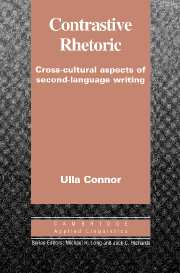Preface
Published online by Cambridge University Press: 05 October 2012
Summary
During this book's gestation, I was influenced by several competing view-points of writing research. Along with many others in the profession, Robert B. Kaplan's 1966 seminal “doodles” article had a great impact on my teaching and L2 writing research. For five consecutive years, Bob Kaplan and I organized a session on contrastive rhetoric at the International TESOL Conference. During this period the late John Hinds transformed contrastive rhetorical research because of his rigorous text analysis combined with an acute understanding of the LI languages and cultures. John Hinds was a forceful presence at our contrastive rhetoric colloquia at TESOL. The proceedings eventually resulted in a collection of essays that redirected contrastive rhetoric towards a more text analytic approach (Connor and Kaplan, 1987).
Since the mid 1980s, four notable experiences – outside the mainstream ESL/EFL teaching – have shaped my views about the teaching and research of writing. First, collaborating with the rhetorician Janice Lauer in research on persuasive writing cross-culturally proved a valuable link in connecting classical theories of rhetoric and composition for LI writers in the United States with the study of second-language writing. Second, my association with the International Education Achievement Project, directed by Alan C. Purves, on the writing achievement of school students in 14 countries was an eye-opener about the need for carefully designed writing tasks, scoring scales, and systems of analyses in cross-cultural analyses of writing.
Information
- Type
- Chapter
- Information
- Contrastive RhetoricCross-Cultural Aspects of Second Language Writing, pp. xiii - xviPublisher: Cambridge University PressPrint publication year: 1996
